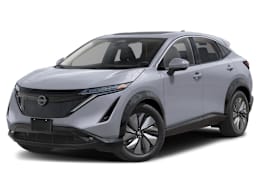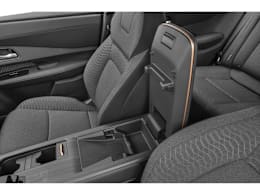Nissan was an electric vehicle pioneer when it introduced the Leaf in 2011, the first mass-produced EV sold in North America. As such, we had high expectations for its long-awaited sophomore effort, the Ariya. It’s a highly-desirable small-SUV size, with an elevated driving position and a large cargo area. We found it quick, quiet, and roomy, and it has a decent driving range.
But beyond the rather cool, minimalist interior design, there isn’t much that screams “forward thinking.” For example, the Ariya is merely middle-of-the-road when it comes to EV-specific attributes, with a disappointingly weak onboard charger, merely average DC fast-charging capabilities, and the lack of a “one-pedal driving” option. Handling agility also isn’t inspiring, the suspension allows too many hard hits to punch through, the brake pedal is overly grabby at low speeds, and some of the controls are difficult to use.
The larger, 87-kilowatt-hour battery we opted for managed a decent 253 miles in our 70-mph highway range test. But a puny 7.2-kilowatt onboard charger (most EVs are between 9.6 to 11 kW) means the Ariya only gains about 20 miles of range per hour of home charging, compared with the 35 miles or so that some other EVs get. Further, its 130-kW max acceptance rate at public DC fast chargers lags behind EVs from Hyundai and Kia. That said, we saw the battery go from an 18-percent state-of-charge to 71 percent during a 30-minute stop at an Electrify America venue, going from 53 miles of predicted driving range to 211 miles of range, which isn’t bad. It helps that it managed a peak rate of 115 kW, which means it got much closer to its maximum acceptance rate than we’ve seen many EVs manage.
But we were thoroughly frustrated when it came to unplugging the Ariya. Releasing the coupler gets confusing when the door locks become out of sync with the cable lock. Sometimes you have to first re-lock the car, then unlock it in order to release the cable.
As is the norm with most EVs, the Ariya’s power is smooth and plentiful, aided by our Platinum+ test model’s 389 horsepower stemming from its dual electric motors, which also give it all-wheel drive (Nissan refers to the Ariya’s all-wheel-drive system as “e-4ORCE”). We were impressed with the nicely-tuned accelerator pedal, which makes for effortless, lurch-free, and nearly-silent motoring. The all-wheel-drive system puts the power down to all four wheels smartly, without excessive front wheelspin. If you really plant your right foot, the Ariya moves down the road with some force, shown by its 5.4-second sprint from 0 to 60 mph, which is midpack within a very speedy class of EV SUVs.
Unfortunately, other aspects of the Ariya aren’t as dynamic. For instance, although the firm suspension initially feels comfortable, encountering even moderately large bumps sends pronounced kicks into the cabin. Larger or multiple road imperfections in a row can result in a jiggly sensation, which makes the Ariya feel unrefined. This, despite the fact that the handling isn’t all that impressive. It lacks much of the agile feeling we’ve come to expect from EVs, due to their low-mounted battery packs. Although the steering turns into corners pretty naturally, the power-assist has an artificial feel, and body roll ramps up quickly if you push the pace. There isn’t the kind of driver engagement here that makes you want to zing along on curvy roads. On the bright side, the Ariya responds nicely to quick changes to the accelerator pedal, and it was competent—though not class-leading—through our avoidance-maneuver test.
Panic-brake stopping distances were appropriately short at our test track, but the spongy-feeling brake pedal can be grabby at low speeds, making it difficult to stop smoothly. We also don’t like Nissan’s “e-Step” mode, a regenerative-braking setting that slows the car aggressively. It causes the brake pedal to eerily move toward the floor on its own when you let off the accelerator pedal, slowing the Ariya while recouping energy and sending it back to the battery. But unlike true “one-pedal driving” modes found in many other EVs, it won’t bring the Ariya to a complete stop, so you still have to press your foot on the brake pedal. Not only is it disconcerting that the pedal isn’t where you thought it would be, but the sensation when you do press down on it is that you’re stepping on a brick.
At least the cabin is quiet and largely free of extraneous electric whines or wind noise at high speeds. We also like the interior’s neat, minimalistic look. The matte-finish wood trim and huge swaths of soft, well-padded suede on the doors and dash are true delights, although not surprising given our top Platinum+ trim’s $63,000 as-tested price.
But although they look cool, those flush, touch-sensitive climate “buttons” that are embedded into the wood are difficult to press without looking carefully over at them, and it’s annoying and distracting that the seat-heater, steering-wheel heat, and airflow mode controls are buried in a menu on the infotainment touchscreen.
The Ariya’s comfortable front seats have well-defined bolsters that provide a body-hugging pocket to help keep you secure through corners—yet they don’t feel overly narrow, like in some cars. We also appreciate the lack of driver’s right-knee intrusion, aided by the way the power-operated center console can slide forward and backward with the touch of a button—a unique touch. But the door armrest proved uncomfortably low and far away for several drivers, and the driving position is hampered by the steering wheel’s bus-like angle, even when it’s tilted down to its lowest.
The rear seat is reasonably comfy and roomy, thanks to plush cushions, good foot space underneath the front seats, decent knee room, and just enough headroom for taller passengers. The bottom cushion’s relatively close proximity to the floor results in less-than-ideal underleg support, though. The seatback only has a slight amount of recline-ability, but most of our testers found the posture raked back enough to be fairly comfortable.
The standard “Nissan Safety Shield 360” suite of active safety and driver assistance features includes automatic emergency braking with pedestrian detection, automatic emergency braking that operates at highway speeds, blind spot warning, rear cross traffic warning, reverse automatic emergency braking, lane departure warning, and automatic high beams. Lane centering assistance, lane keeping assistance, and adaptive cruise control also come standard. High-end versions have the ProPILOT Assist 2.0 active driving assistance system, which allows hands-free driving on certain highways, including the ability for the Ariya to change lanes on its own.


























